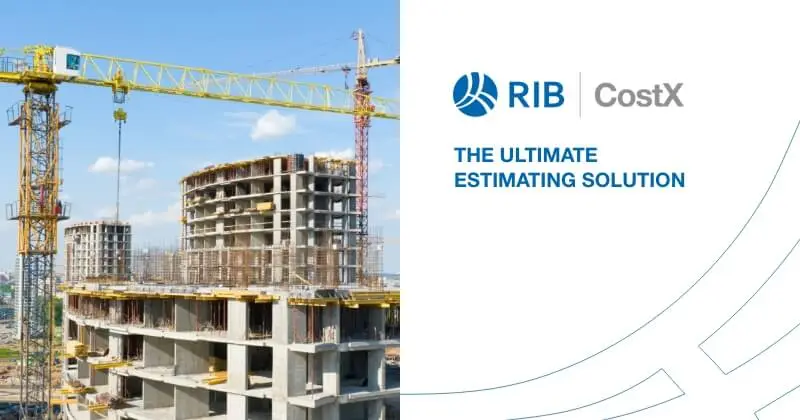10 mins read
What is Conceptual Estimating? Removing Cost Uncertainty Supports Informed Decisions

One of the greatest dilemmas in construction, and many other industries, is the inability to anticipate all costs, risks, and roadblocks before launching a complex and expensive new project. Conceptual estimating combines the limited data that is available with historical information to deliver preliminary cost predictions that reduce uncertainty.
In this blog post, we discuss the idea of conceptual estimates, along with their pros and cons and the practices that help to make them as accurate as possible. At the same time, we look at some of the ways software and technology are improving the construction cost estimation process.
What is Conceptual Estimating?
Conceptual estimating is a process used to determine the approximate cost of a project in the early stages of design and development before detailed drawings and specifications are available. These efforts help stakeholders decide on the viability of a new concept.
A lack of information on design details, specific site conditions, project timelines, and other key inputs leads to a higher margin of error for preliminary estimates that must be understood and accepted by those reviewing the numbers. Conceptual estimates are usually not precise enough to establish a formal project budget or timeline. Still, they can help build a foundation for the following design, staffing, and material selection decisions.
When does conceptual estimating happen?
As the name implies, conceptual cost estimating takes place in the conceptual phase of the project, while plans are still being formed and adapted. Since information on the actual material, quantity, and labor requirements is usually limited at this stage, historical data is leveraged to anticipate costs. These estimates provide guidance for architects, designers, and construction project managers as they adjust the project scope to align with budgetary goals.
The type of estimating that happens early in the preconstruction planning phase is very different from the standard cost-estimating processes that continue throughout the life of the project. A conceptual estimate based on pre-build information must rely heavily on industry norms and historical data, whereas construction cost estimates factor in real-time information based on known materials, quantities, and subcontractor rates.
Benefits & Challenges of Conceptual Estimates
Conceptual estimating enables owners, project managers, and other stakeholders to anticipate the total cost of a project at a stage when decisions on design concepts, site location, and other cost drivers can still be changed relatively easily. For example, the impact of budget-friendly materials can be factored into an early estimate to weigh the cost impact vs. the perceived quality or aesthetic drawbacks. Additional benefits of conceptual estimating in construction include:
- Reduced estimation time compared to traditional methods
- Providing a basis for comparison between projects
- Input for preliminary budget planning
At the same time, conceptual estimates are inexact, so an over-reliance on these preliminary results for important decisions can introduce project risks. Additional drawbacks associated with the limited estimating process and the resulting inaccuracy include:
- Frequent adjustments needed to address scope changes
- Market fluctuations in labor and materials before project kick-off
- Unforeseen site, design, or logistical challenges and complexities
- Incorrect assumptions leading to improper allocation of resources
Conceptual Estimating Best Practices & Tips

To maximize the benefits of conceptual estimating while avoiding the potential pitfalls, project teams can leverage software, technology, and fundamental project management principles to apply high standards to both conceptual and standard cost estimating processes.
1. Review all available project data
The lack of finalized project details does not prevent a rigorous estimation process. Historical cost data for similar projects can be mined from sources including cost databases, construction bid sites, and trade associations. Attention to detail is essential, since equipment, overhead, insurance, and other historical costs must be carefully reviewed to see which are applicable to the current project.
Statistical techniques like data normalization and trend analysis improve the quality of analogous estimating based on historical data, and help to ensure conditions that change over time are factored into the estimate. Information gathered on factors like the proposed project site or skilled labor availability also enhances the accuracy of the estimate.
2. Collaborate with stakeholders
Close collaboration with experts and key partners, including subcontractors, project managers, construction architects, and suppliers with recent experience working on similar projects, helps to compensate for the long list of project unknowns. Along with timely information and insight into cost and risk factors, key stakeholders can share their ideas and recommendations to identify where cost savings can be found.
Regular collaboration throughout the conceptual phase can be accomplished through periodic face-to-face meetings, online collaboration forums, and Email exchanges. Construction collaboration software platforms are also a useful resource for sharing ideas and communicating on project parameters and decisions.
3. Document all assumptions
Any information that is not available to complete a conceptual cost estimate is addressed through assumptions on design choices and the overall direction the project is expected to take. While this “gap-filling” is unavoidable, assumptions can also be a source of error and uncertainty when they stray too far from reality.
The best way to minimize this risk is by clearly documenting and communicating these assumptions to project owners and other interested parties. This level of transparency provides an opportunity for assumptions to be corrected or revised and highlights any knowledge gaps that may impact the estimate in a significant way.
4. Utilize risk management practices
Conceptual estimating and construction risk management are closely interrelated since the preliminary estimating process highlights areas of uncertainty that introduce risk, and the risk analysis process points to unknowns and challenges that can potentially increase project costs. This synergy makes it useful to complete risk analysis and cost estimation processes in parallel, along with contingency planning to address the impact of risks and unknowns on the project budget.
The early emphasis on cost estimation and risk analysis also supports effective feasibility studies in the preconstruction phase, where financial, design, and operational considerations are weighed and rated to decide whether the project concept is viable.
5. Update estimates over time
Perhaps the most important practice to ensure conceptual estimates serve their intended purpose is a continuous review to incorporate any scope changes, market insights, or design revisions immediately. As the plans begin to solidify, new information will only improve the accuracy of the estimate. Treating conceptual estimating as an iterative (rather than static) process also helps to compensate for any outdated historical information, labor rates, fuel costs, and other factors that can change dramatically in a short period of time.
By following this iterative approach, the outcome gradually evolves from a rough order of magnitude (ROM) estimate based on minimal information, to a full conceptual estimate that includes a line-by-line breakdown for each item. This evolved format provides a basis for the detailed cost estimates utilized during the construction phase.
6. Leverage real-time databases
Assumptions and information gaps are inevitable but digital construction technology has given us valuable resources to ensure the pricing and cost information feeding into conceptual estimates is as accurate and timely as possible. The wide variety of online options includes cloud-based cost databases, price trackers, and industry dashboards.
Software tools for construction estimating, collaboration, and reporting also allow estimating spreadsheets to be live linked to drawings and data repositories, so that estimates are updated seamlessly when material costs or quantities change.
7. Utilize cost estimating software
New technology is helping to remove uncertainty and error from the construction estimating process, and these benefits also extend to the conceptual phase. Emerging technologies like artificial intelligence (AI) and predictive analytics help to fill in gaps with greater precision, while advanced takeoff and estimation software, like RIB CostX, supports error-free results throughout the project lifespan, with efficient workflows that save time when compared to traditional estimating methods.
The advanced software technology from RIB CostX also makes it easier to quickly compare the cost of multiple design options, even with different drawing or modeling formats, making the financial impact of any design changes easily visible to all stakeholders.
Conclusion
Every successful project begins as an idea, with estimates of the cost, scope, and risk limited by the accuracy of assumptions and the availability of historical data. Conceptual estimating practices benefit from new software and technology that improve speed and accuracy. RIB CostX, our estimating and BIM takeoff software supports conceptual estimating through flexible takeoff, estimating, and reporting features that accommodate the unique aspects of each project. RIB CostX also provides powerful embodied carbon calculations, subcontractor comparisons, and revision tracking capabilities to skyrocket your project’s performance.
Leave all the challenges and hurdles of traditional estimating in the past, and benefit from unmatched speed, accuracy, and precision. Get your free demo for RIB CostX today!

Most Recent
10 mins read
11 mins read
11 mins read
10 mins read
Blog Categories

Ebook











